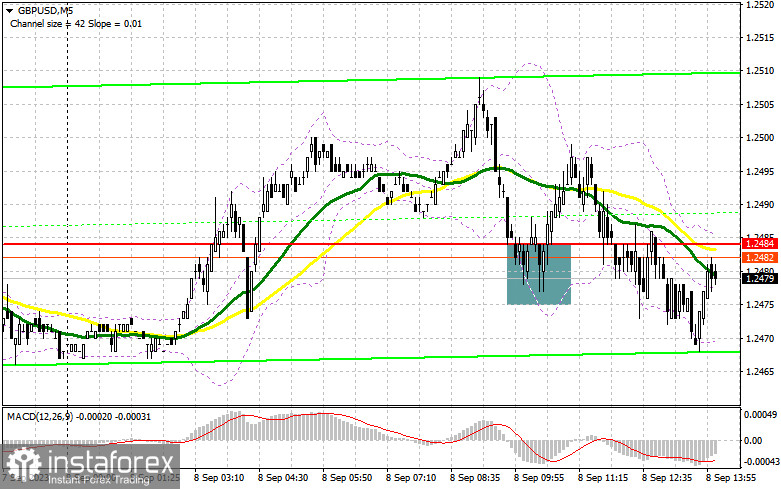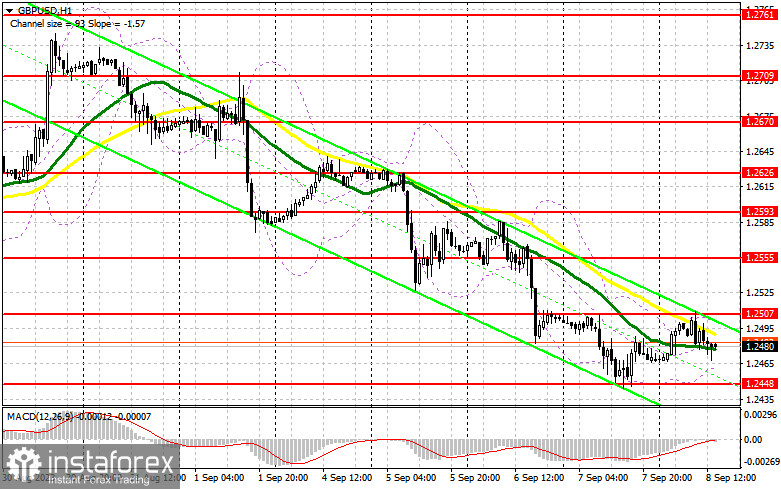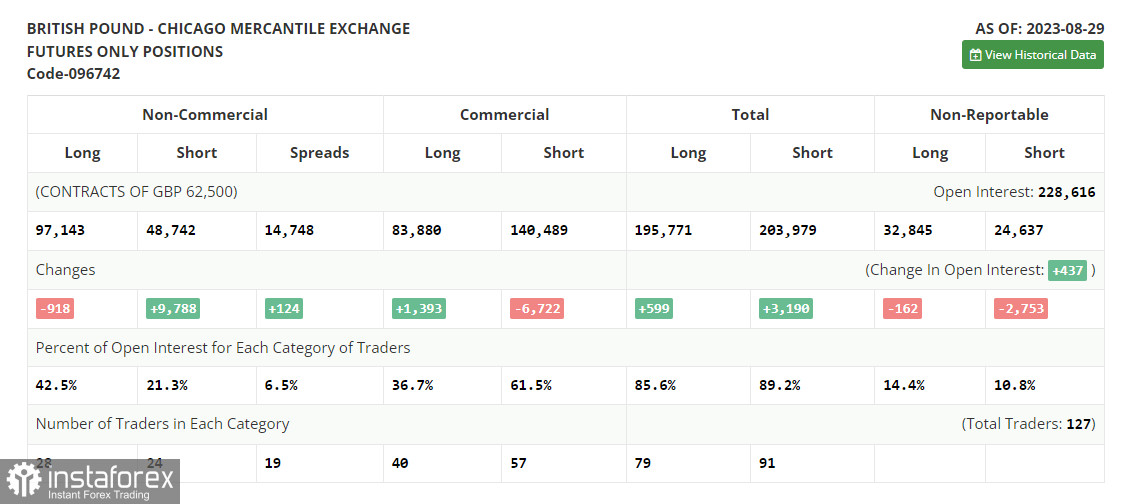In my morning forecast, I drew attention to the level of 1.2484 and recommended making decisions regarding market entry based on it. Let's look at the 5-minute chart and analyze what happened there. A drop and a false breakout at this level signaled a buy, but after a 15-point upward movement, pressure returned to the pair. In the second half of the day, the technical picture was reevaluated.

To open long positions on GBP/USD, the following is required:
Considering the low volatility, likely to persist into the second half of the day, it's better not to rush into the market. The absence of US statistics will also affect the volume, so there's no need to count on breakthroughs and consolidation at the next monthly lows. In the case of further pair decline, I plan to act against the bearish market only if a false breakout forms at 1.2448 – the new monthly low, which would provide an entry point for a buy with a subsequent recovery to 1.2507. A breakthrough and consolidation above this range will restore confidence to buyers, signaling a buy with an exit at 1.2555. The further target will be the area around 1.2593, where I will take profit. In the scenario of further decline in GBP/USD due to hawkish comments from Federal Reserve representatives and the absence of bulls at 1.2448 in the second half of the day, pressure on the pound will persist, along with the likelihood of a further significant drop in the pair. In such a case, only the defense of the next area at 1.2419 and a false breakout at that level will signal the opening of long positions. I plan to buy GBP/USD immediately on a rebound only from 1.2395 with the goal of a 30-35 point correction within the day.
To open short positions on GBP/USD, the following is required:
Bears must defend the nearest resistance at 1.2507, where slightly below the moving averages pass, favoring sellers. Only after an unsuccessful consolidation at 1.2507 can we get a sell signal with the prospect of further decline to the area of 1.2448. A breakthrough and a reverse test from below this range will deliver a more serious blow to the positions of the bulls, providing an opportunity to update the monthly minimum at 1.2419. The further target remains the area around 1.2395, where I will take profit. In the event of GBP/USD rising and the absence of activity at 1.2507 in the second half of the day, buyers will attempt to re-enter the market, counting on the formation of an upward correction. In this case, I will postpone selling until a false breakout at 1.2555. If there is no downward movement even then, I will sell the pound only on a rebound from 1.2593, but with the expectation of a 30-35 point downward correction.

In the COT report (Commitment of Traders) as of August 29, there was a reduction in long positions and an increase in short positions. Strong US labor market data and remarks by Federal Reserve Chairman Jerome Powell were the main reasons for the sharp increase in short positions on the pound. There has been rather discouraging data from the UK recently, indicating a future recession, so pressure on the pound is expected to persist in the autumn of this year. However, this can be an opportunity for buyers because the lower the pound, the more attractive it becomes for medium-term purchases. The difference in central bank policies will continue to impact GBP/USD positively. The latest COT report noted that long non-commercial positions decreased by only 918 to a level of 97,143, while short non-commercial positions increased by 9,788 to 48,742. As a result, the spread between long and short positions increased by 124. The weekly price dropped and amounted to 1.2624 compared to 1.2741.

Indicator Signals:
Moving Averages
Trading is taking place below the 30 and 50-day moving averages, indicating further decline of the pair.
Note: The author considers the period and prices of moving averages on the H1 hourly chart, which differs from the general definition of classical daily moving averages on the D1 daily chart.
Bollinger Bands
In the case of a decrease, the lower boundary of the indicator, around 1.2448, will act as support.
Description of Indicators
• Moving average (determines the current trend by smoothing volatility and noise). Period 50. Marked on the chart in yellow.
• Moving average (determines the current trend by smoothing volatility and noise). Period 30. Marked on the chart in green.
• MACD indicator (Moving Average Convergence/Divergence — convergence/divergence of moving averages). Fast EMA period 12. Slow EMA period 26. SMA period 9.
• Bollinger Bands. Period 20.
• Non-commercial traders - speculators such as individual traders, hedge funds, and large institutions using the futures market for speculative purposes and meeting certain requirements.
• Long non-commercial positions represent the total long open positions of non-commercial traders.
• Short non-commercial positions represent the total short open positions of non-commercial traders.
• The total non-commercial net position is the difference between non-commercial traders' short and long positions.
 English
English 
 Русский
Русский Bahasa Indonesia
Bahasa Indonesia Bahasa Malay
Bahasa Malay ไทย
ไทย Español
Español Deutsch
Deutsch Български
Български Français
Français Tiếng Việt
Tiếng Việt 中文
中文 বাংলা
বাংলা हिन्दी
हिन्दी Čeština
Čeština Українська
Українська Română
Română

